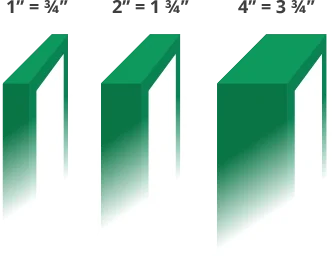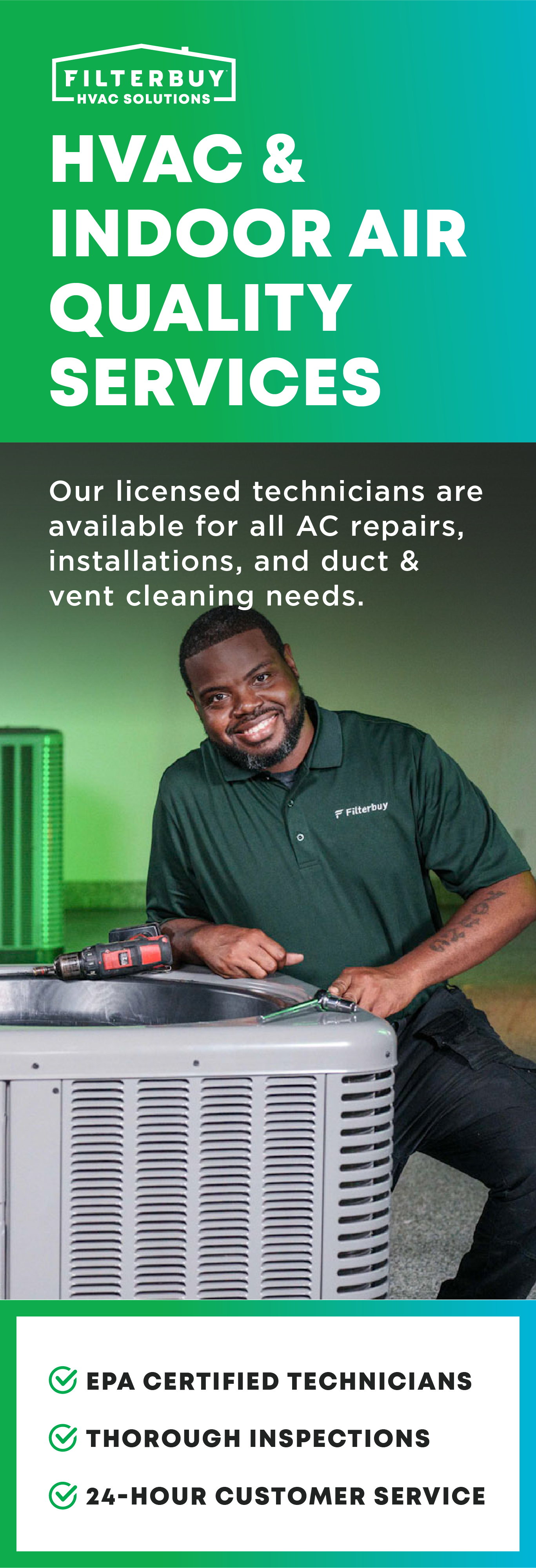Due to their moist environment, home air ducts are susceptible to mold and mildew growth. Mold in your vents system is not only an inconvenience, but it can also be dangerous. Mold spores can enter your indoor air through your air vents, causing physical symptoms and reducing your home air’s safety. This is why knowing when to schedule an HVAC mold remediation is essential to a happy and healthy home.
If your ducts are infected, there are a few ways to identify mold in your HVAC system and air vents:
Musty Smell - As mold releases spores into your living space, it also produces gasses. While sometimes these gasses are scentless, rancid or musty smells can also occur. A strong musty smell is a sign that mold might be growing in your air ducts.
- Noticeable Black Mold or Dust - Have you noticed any black spotting or dust coming from your air intake vents? If so, chances are high that mold is to blame. Noticing any very dark, wet growth is an immediate reason to schedule an air duct cleaning inspection and appointment.
- Coughing, wheezing, sneezing - If you have allergy-like symptoms without a known cause, you may want to check your ducts. Hidden away in your vents, mold can still release spores into your indoor air. Often, mold spore-exposure symptoms begin with common allergy responses, such as coughing, wheezing, and sneezing.
- Unidentified Illness - Experiencing any unidentified respiratory illness consistently at home could be a symptom of mold exposure. If you’re feeling sick indoors, your symptoms worsen in specific rooms in your home, and you’ve tested negative for illnesses like Covid-19, you may want to schedule a duct inspection.
These are some of the most common signs of HVAC system mold growth. If you believe you may be experiencing symptoms or can visibly see mold growth in your ducts, seek professional help. A professional HVAC mold cleaning from a specialist is the best course of action.
Noticing Black Mold and Black Dust?
While some common mold growth may be recognizable to most homeowners, black mold often goes unnoticed in HVAC systems due to its dust-like appearance. The air vents around your home may attract some general dust, but if you notice the dust getting much darker or having a soot-like color, it may be black mold.
In this case, you should schedule an appointment with an HVAC mold cleaner right away. The longer you wait to clear the air duct of mold, the more spores you will breathe in, and the more your indoor air quality will be affected.
.jpg)
Is Mold in Your HVAC Dangerous?
Regardless of whether or not mold is visible, any significant mold growth in your HVAC system can be harmful to you, your family, and your pets. As previously mentioned, all different types of common at-home mold release spores into the air you breathe.
Mold spores can trigger illnesses, including allergy-like symptoms in those without previous respiratory issues. If someone in your home has a respiratory condition, like asthma or a lung infection, mold spores can also trigger attacks, worsen daily symptoms, and lower their breathing quality.
How Does Mold Testing Work?
There are two main mold test practices: buying a testing kit or hiring a professional mold inspector. Kits, though very convenient, can be somewhat less reliable than a test from a professional. This is why we at Filterbuy always recommend the professional route. That said, if you need to know if you have mold quickly or simply want to confirm already visible growth, an at-home testing kit may be the most convenient option.
While mold testing practices may vary by the practitioner, most inspectors test for mold in relatively similar ways. When beginning a professional test, an inspector will gather a sample of mold growth. This can be either a test taken from indoor air to locate spore presence or a test applied to visible mold growth. According to Mold Report, there are three main ways that professionals capture a mold sample:
- Bulk - A section of the infected area is physically removed and used as a sample.
- Swab - The technician uses a sticky swab to capture mold particles and spores. The swab then becomes the lab sample.
- Tape - The technician presses a specialized tape onto the growth or infected area. The tape's sticky side is the sample during analysis.
The mold inspector will take the samples to the lab to confirm the presence and type of mold growth. They will then often recommend the next steps for mold removal.
Is Mold Common in HVAC Systems and Air Ducts?
Unfortunately, mold growth in heating and cooling systems is more common than you may think. Your HVAC system, including your air ducts, is the perfect habitat for fungi, due to the moist environment and varying temperatures.
While mold can grow anywhere with the right temperature and conditions, there are a few places in HVAC systems where mold growth is more likely to occur. If you suspect mold in your system, here are a few areas you may want to check:
- Air Ducts - Air ducts are one of the most common areas for mold growth in your heating and cooling system. With moisture present in the ducts and shifting temperatures between 60-90 degrees, it’s no surprise that these areas tend to experience mold and mildew growth more than other HVAC components.
- Evaporator Coil - The evaporator coil is the part of your system that cools down warm air and removes excess air moisture. The direct exposure to wet and warm air makes your coil a common place for mold growth. If you believe you have mold in your system and have already checked the air duct, the evaporator coil may be the culprit.
- Drain Pan - Much like the evaporator coil, the drain pan deals with moisture run-off in your system. The drain pan surface can become a breeding ground for mold spores and bacteria when excess water drips into it from the HVAC system.
If you suspect mold growth within your heating and cooling equipment, it’s important to have your entire system inspected by a professional. In a self-inspection, you may only see a part of the infected system or miss an area of your system where mold is present. An HVAC professional should identify all areas of concern and provide suggestions, such as air duct cleaning for infestation removal.

What Causes Mold in HVAC Systems and Air Ducts?
The most common causes of mold in HVAC systems and air ducts are moist, warm internal temperatures. Humidity, indoor air climate, and HVAC usage can all affect mold growth and how susceptible a system is.
If you believe that your heating and cooling system is mold infected, you should turn your system off right away. As the EPA confirms:
An HVAC system found to be contaminated with mold should be turned off and not used until the system has been remediated; using a mold-contaminated HVAC system may spread mold throughout the building and increase the exposure of building occupants…If possible, the HVAC system should be remediated during off-hours when the building is not in use.
While black mold can be especially present in air duct systems, other fungi also grow within HVAC systems, such as Alternaria, Mucor, Acremonium, Fusarium, and Chaetomium. When inhaled repeatedly, these strains are harmful to your health, so turn off your unit as soon as possible to prevent spreading spores.
Can Mold Be Cleaned Out of My HVAC and Air Ducts?
Using proper techniques and antimicrobial agents, a professional HVAC mold cleaner can remove mold from your duct system and even prevent future growth.
To kill present mold and disinfect the area, technicians apply an HVAC mold inhibitor (often called a biocide or antimicrobial solution) to the air ducts. Note: Not all sanitizing solutions are created equal, and some may contain chemicals that are not made for indoor use. If you plan to employ an air duct cleaning company, ask them what HVAC cleaning mold solution they use and do your research. Hiring a trusted air duct cleaning service that uses gentle, high-quality antimicrobial solutions is always the best choice for your home safety.
When done correctly and by a trained professional, this process can effectively remove mold and remaining spores that could cause future mold growth. If you have any questions about the mold cleaning process, be sure to ask your air duct servicer during your preliminary consultation. A trusted, local HVAC cleaning company should be able to discuss specifics about their process with you and provide answers.
How Much Does it Cost to Remove Mold and Apply an HVAC Mold Inhibitor?
HVAC mold treatment (including an HVAC mold inhibitor) should only be done by a trained technician. While DIY mold treatments are cheap, they can contain harmful chemicals or low-grade ingredients. These solutions are often less effective at treating the mold than professional-level biocides, leaving spores behind and allowing regrowth without proper application.
Professional mold removal cost varies depending on your location, scope of the cleaning, and HVAC cleaning company experience. Generally, HVAC mold cleaning costs range from $500 - $2500, due to the equipment and time needed to complete a full-scale cleaning. Companies may charge a flat rate for their service or give a general cleaning quote.
Before agreeing to have an HVAC mold remediation service in your home, ask if there are any additional costs that could factor into the quote given to you. This should help you plan for the final service cost.
While very low service prices may be tempting, they could also signal low-quality HVAC mold inhibitors usage, untrained technicians, or improper equipment. To ensure that your HVAC system is safe and protected during cleaning, invest in a trusted mold cleaning company with clear safety protocols and a reputable service record.

Finding an HVAC Cleaning Mold Professional
If you believe that you have mold growth in your HVAC system, make hiring a reliable professional to inspect and clean the infestation a priority. The longer the mold goes without treatment, the more it can negatively affect your indoor air quality and the safety of your home.
If you suspect mold in your air ducts, contact Filterbuy Local today to schedule a quality duct inspection. Our trained technicians will look over your system and guide you in the proper direction for mold remediation.
Filterbuy Local’s Air Duct Sanitization service is another way to keep your system clean and free of harmful bacteria. The family and pet-safe disinfectant fogging used by our service professionals targets invisible pollutants, such as dust mites, mold spores, viruses, and more - helping you breathe better.
Click here to learn more about Filterbuy LOCAL for air duct cleaning

.webp)
.webp)
.webp)
.webp)







